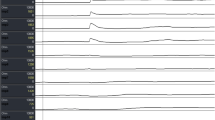Abstract
Introduction
Voluntary muscle activity, including swallowing, decreases during the night. The association between nocturnal awakenings and swallowing activity is under-researched with limited information on the frequency of swallows during awake and asleep periods.
Aim
The aim of this study was to assess nocturnal swallowing activity and identify a cut-off predicting awake and asleep periods.
Methods
Patients undergoing impedance-pH monitoring as part of GERD work-up were asked to wear a wrist activity detecting device (Actigraph®) at night. Swallowing activity was quantified by analysing impedance changes in the proximal esophagus. Awake and asleep periods were determined using a validated scoring system (Sadeh algorithm). Receiver operating characteristics (ROC) analyses were performed to determine sensitivity, specificity and accuracy of swallowing frequency to identify awake and asleep periods.
Results
Data from 76 patients (28 male, 48 female; mean age 56 ± 15 years) were included in the analysis. The ROC analysis found that 0.33 sw/min (i.e. one swallow every 3 min) had the optimal sensitivity (78 %) and specificity (76 %) to differentiate awake from asleep periods. A swallowing frequency of 0.25 sw/min (i.e. one swallow every 4 min) was 93 % sensitive and 57 % specific to identify awake periods. A swallowing frequency of 1 sw/min was 20 % sensitive but 96 % specific in identifying awake periods.
Summary and Conclusion
Impedance-pH monitoring detects differences in swallowing activity during awake and asleep periods. Swallowing frequency noticed during ambulatory impedance-pH monitoring can predict the state of consciousness during nocturnal periods.



Similar content being viewed by others
References
Lichter I, Muir RC. The pattern of swallowing during sleep. Electroencephalogr Clin Neurophysiol. 1975;38:427–432.
Hiestand DM, Britz P, Goldman M, Phillips B. Prevalence of symptoms and risk of sleep apnea in the US population: results from the national sleep foundation sleep in America 2005 poll. Chest. 2006;130:780–786.
Dubois RW, Aguilar D, Fass R, et al. Consequences of frequent nocturnal gastro-oesophageal reflux disease among employed adults: symptom severity, quality of life and work productivity. Aliment Pharmacol Ther. 2007;25:487–500.
Shaker R, Castell DO, Schoenfeld PS, Spechler SJ. Nighttime heartburn is an under-appreciated clinical problem that impacts sleep and daytime function: the results of a Gallup survey conducted on behalf of the American Gastroenterological Association. Am J Gastroenterol. 2003;98:1487–1493.
Ancoli-Israel S, Cole R, Alessi C, Chambers M, Moorcroft W, Pollak CP. The role of actigraphy in the study of sleep and circadian rhythms. Sleep. 2003;26:342–392.
Sadeh A, Acebo C. The role of actigraphy in sleep medicine. Sleep Med Rev. 2002;6:113–124.
Hila A, Chowdhury N, Hajar N, Castell DO. Swallow evaluation during multichannel intraluminal impedance and pH: an alternate method to assess esophageal transit. J Clin Gastroenterol. 2011;45(10):862–866.
Thie NM, Kato T, Bader G, Montplaisir JY, Lavigne GJ. The significance of saliva during sleep and the relevance of oromotor movements. Sleep Med Rev. 2002;6:213–227.
Sato K, Umeno H, Chitose S, Nakashima T. Deglutition and respiratory patterns during sleep in younger adults. Acta Otolaryngol. 2011;131:190–196.
Freidin N, Fisher MJ, Taylor W, et al. Sleep and nocturnal acid reflux in normal subjects and patients with reflux oesophagitis. Gut. 1991;32:1275–1279.
Paquet J, Kawinska A, Carrier J. Wake detection capacity of actigraphy during sleep. Sleep. 2007;30:1362–1369.
Orr WC, Goodrich S, Robert J. The effect of acid suppression on sleep patterns and sleep-related gastro-oesophageal reflux. Aliment Pharmacol Ther. 2005;21:103–108.
Tutuian R, Castell DO. Review article: complete gastro-oesophageal reflux monitoring—combined pH and impedance. Aliment Pharmacol Ther. 2006;24:27–37.
Acknowledgments
This study was not financially supported by external sources. Costs were covered by a personal research fund of the Medical University of South Carolina for investigator Prof. Donald Castell, Digestive Disease Center, MUSC, USA.
Conflict of interest
None.
Author information
Authors and Affiliations
Corresponding author
Rights and permissions
About this article
Cite this article
Pohl, D., Arevalo, F., Singh, E. et al. Swallowing Activity Assessed by Ambulatory Impedance-pH Monitoring Predicts Awake and Asleep Periods at Night. Dig Dis Sci 58, 1049–1053 (2013). https://doi.org/10.1007/s10620-012-2474-z
Received:
Accepted:
Published:
Issue Date:
DOI: https://doi.org/10.1007/s10620-012-2474-z




